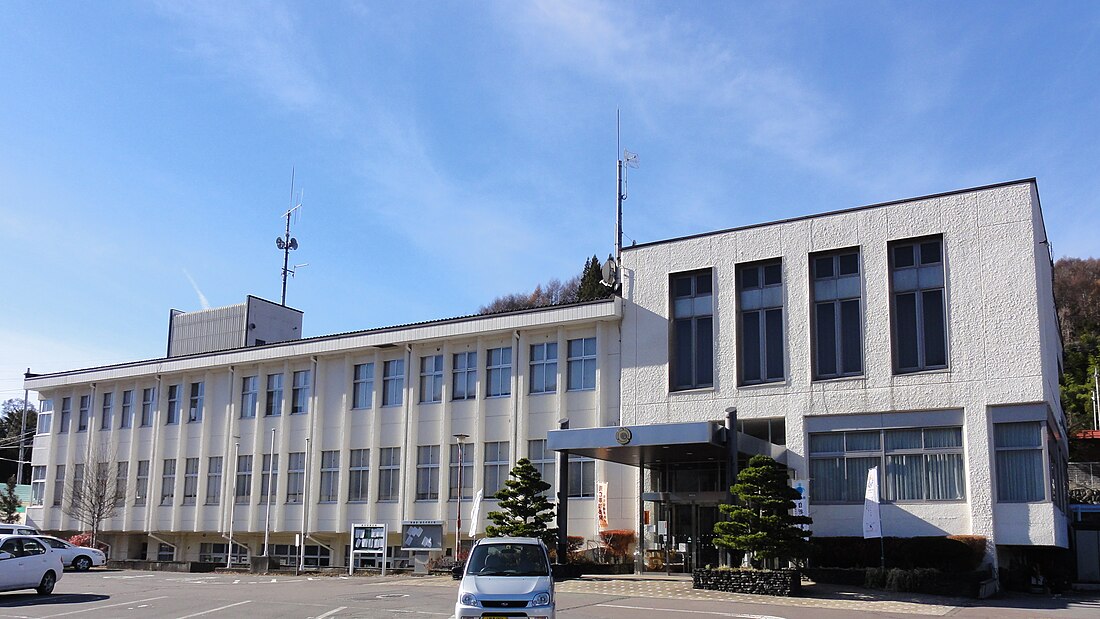Tsumagoi (嬬恋村, Tsumagoi-mura) is a village located in Gunma Prefecture, Japan. As of 1 September 2020[update], the village had an estimated population of 9,546 in 3,999 households,[1] and a population density of 28 persons per km². The total area of the village is 337.51 square kilometres (130.31 sq mi).
Tsumagoi
嬬恋村 | |
|---|---|
 Tsumagoi village office | |
 Location of Tsumagoi in Gunma Prefecture | |
| Coordinates: 36°31′0.6″N 138°31′48.5″E | |
| Country | Japan |
| Region | Kantō |
| Prefecture | Gunma |
| District | Agatsuma |
| Area | |
| • Total | 337.58 km2 (130.34 sq mi) |
| Population (September 2020) | |
| • Total | 9,546 |
| • Density | 28/km2 (73/sq mi) |
| Time zone | UTC+9 (Japan Standard Time) |
| - Tree | Silver birch |
| - Flower | Japanese Gentian |
| - Fish | Oncorhynchus masou |
| Phone number | 0279-96-0511 |
| Address | 110 Ōmae, Tsumagoi-mura, Agatsuma-gun, Gunma-ken 377-1692 |
| Website | Official website |

Geography
Tsumagoi is situated on the northwestern corner of Gunma Prefecture, touching Nagano Prefecture to the north, south, and west. Because of its elevated location and the ash deposits of Mount Asama, Tsumagoi is well known for growing cabbages. Parts of the village are within the borders of then Jōshin'etsu-kōgen National Park.
- Mountains: Mount Asama (2568m), Mount Motoshirane (2171m), Mount Kusatsu-Shirane (2160m), Mount Azumaya (2354m)
- Rivers: Agatsuma River
- Lakes: Lake Baragi, Lake Tashiro
Surrounding municipalities
Climate
Tsumagoi has a humid continental climate (Köppen Dfb) characterized by warm summers and cold winters with heavy snowfall, due to the high elevation. Winters are cold, with a January 24-hour average temperature of −4.6 °C (23.7 °F), while summers are warm and wet, with a July 24-hour average temperature of 19.5 °C (67.1 °F). The average annual rainfall is 1345 mm with September as the wettest month.[2]
| Climate data for Tsumagoi(Tashiro) | |||||||||||||
|---|---|---|---|---|---|---|---|---|---|---|---|---|---|
| Month | Jan | Feb | Mar | Apr | May | Jun | Jul | Aug | Sep | Oct | Nov | Dec | Year |
| Record high °C (°F) | 11.5 (52.7) |
15.2 (59.4) |
19.0 (66.2) |
24.8 (76.6) |
27.7 (81.9) |
29.3 (84.7) |
30.2 (86.4) |
29.9 (85.8) |
29.0 (84.2) |
24.3 (75.7) |
19.3 (66.7) |
15.0 (59.0) |
30.2 (86.4) |
| Mean daily maximum °C (°F) | −0.6 (30.9) |
0.1 (32.2) |
4.0 (39.2) |
11.5 (52.7) |
16.6 (61.9) |
19.6 (67.3) |
23.3 (73.9) |
24.2 (75.6) |
19.6 (67.3) |
14.1 (57.4) |
8.7 (47.7) |
2.9 (37.2) |
12.1 (53.8) |
| Daily mean °C (°F) | −4.6 (23.7) |
−4.3 (24.3) |
−0.9 (30.4) |
5.7 (42.3) |
10.9 (51.6) |
14.7 (58.5) |
18.6 (65.5) |
19.5 (67.1) |
15.3 (59.5) |
9.1 (48.4) |
3.6 (38.5) |
−1.5 (29.3) |
7.2 (45.0) |
| Mean daily minimum °C (°F) | −9.0 (15.8) |
−9.1 (15.6) |
−5.7 (21.7) |
0.4 (32.7) |
5.4 (41.7) |
10.4 (50.7) |
14.9 (58.8) |
15.7 (60.3) |
11.7 (53.1) |
4.6 (40.3) |
−0.9 (30.4) |
−5.9 (21.4) |
2.7 (36.9) |
| Record low °C (°F) | −16.5 (2.3) |
−17.2 (1.0) |
−14.5 (5.9) |
−10.0 (14.0) |
−6.3 (20.7) |
1.8 (35.2) |
7.0 (44.6) |
8.0 (46.4) |
−0.1 (31.8) |
−4.3 (24.3) |
−10.4 (13.3) |
−15.1 (4.8) |
−17.2 (1.0) |
| Average precipitation mm (inches) | 49.0 (1.93) |
60.9 (2.40) |
102.5 (4.04) |
106.9 (4.21) |
138.7 (5.46) |
180.8 (7.12) |
208.7 (8.22) |
175.9 (6.93) |
232.3 (9.15) |
133.8 (5.27) |
74.5 (2.93) |
42.6 (1.68) |
1,506.6 (59.31) |
| Mean monthly sunshine hours | 135.0 | 152.0 | 187.4 | 202.2 | 194.3 | 142.5 | 147.0 | 150.5 | 111.6 | 135.3 | 140.1 | 134.9 | 1,832.2 |
| Source 1: Japan Meteorological Agency[3] | |||||||||||||
| Source 2: Japan Meteorological Agency[4] | |||||||||||||
Demographics
Per Japanese census data,[5] the population of Tsumagoi has recently decreased after several decades of relative stability.
Tsumagoi has been recognized by Japan's Office for the Promotion of Regional Revitalization (Kishida Cabinet Secretariat), which promotes the development of new technologies to combat depopulation, for meeting a "high standard" (高水準) of digital transformation/telework infrastructure. Related projects have been awarded over ¥7.0M in government grants.[6]
| Year | Pop. | ±% |
|---|---|---|
| 1920 | 6,359 | — |
| 1930 | 9,502 | +49.4% |
| 1940 | 9,685 | +1.9% |
| 1950 | 13,757 | +42.0% |
| 1960 | 15,214 | +10.6% |
| 1970 | 12,074 | −20.6% |
| 1980 | 10,737 | −11.1% |
| 1990 | 10,957 | +2.0% |
| 2000 | 10,657 | −2.7% |
| 2010 | 10,183 | −4.4% |
| 2020 | 8,850 | −13.1% |
History
Numerous Jōmon period remains have been found in Tsumagoi, although later Yayoi period artifacts are almost non-existent, as the area is not suitable for rice cultivation. During the Edo period, the area around Tsumagoi was part of the hatamoto-administered territory within Kōzuke Province. Kanbara area (鎌原村) was severely damaged by the Tenmei eruption of Mt. Asama in 1783 (477 people died).[7] With the creation of the modern municipalities system after the Meiji Restoration on April 1, 1889, the village of Tsumagoi was created within Agatsuma District of Gunma Prefecture.
Government
Tsumagoi has a mayor-council form of government with a directly elected mayor and a unicameral village council of 12 members. Tsumagoi collectively with the other municipalities in Agatsuma District, contributes two members to the Gunma Prefectural Assembly. In terms of national politics, the village is part of Gunma 5th district of the lower house of the Diet of Japan.
Economy

The economy of Tsumagoi is primarily agricultural, with cabbage forming the most noted local crop. Seasonal tourism primarily in connection with its onsen hot spring resorts and ski resorts are also major contributors to the local economy.
Education
Tsumagoi has two public elementary schools and one public middle school operated by the town government, and one public high school operated by the Gunma Prefectural Board of Education.
Senior high schools
- Tsumagoi High School
Junior high schools
- Tsumagoi Junior High School
Elementary schools
- Higashi Elementary School
- Nishi Elementary School
Transportation
Railway
Highway
Local attractions
The main draw of tourists to Tsumagoi are the onsen (natural hot spring) resorts, some of which are also associated with ski resorts. There are two major hot spring resort areas within the town.
- Palcall Tsumagoi Mountain Resort
- Manza Onsen and ski resort
- Kazawa Onsen and ski resort
- Tsumagoi Onsen
- Handeki Onsen
Noted people from Tsumagoi
- Akira Kuroiwa, Olympic gold medalist speed skater
- Toshiyuki Kuroiwa, Olympic silver medalist speed skater
- Masato Kobayashi, professional baseball player
References
External links
Wikiwand in your browser!
Seamless Wikipedia browsing. On steroids.
Every time you click a link to Wikipedia, Wiktionary or Wikiquote in your browser's search results, it will show the modern Wikiwand interface.
Wikiwand extension is a five stars, simple, with minimum permission required to keep your browsing private, safe and transparent.



